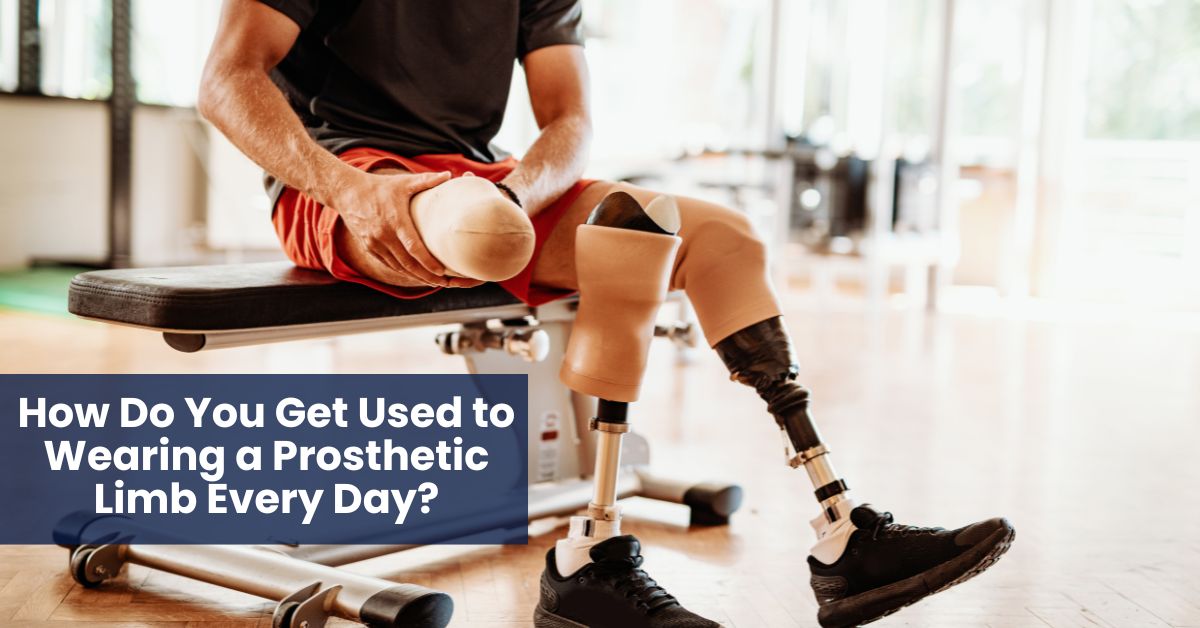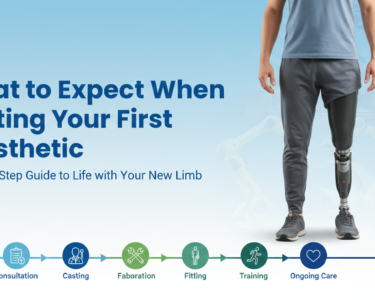Getting used to wearing a prosthetic limb isn’t just a physical adjustment — it’s a mental and emotional journey too. Whether you’ve recently undergone an amputation or are transitioning to a new prosthesis, the process takes time, patience, and support.
Here’s what you can expect, along with practical tips to help you adapt and feel more confident in your daily life.
1. Start Slow – It’s a Gradual Process
When you first begin wearing your prosthesis, don’t rush into wearing it all day. Most prosthetists recommend starting with short sessions — maybe an hour or two — and gradually increasing the time based on your comfort.
You might feel pressure, soreness, or awkwardness in the beginning. That’s normal. Your body is learning something new.
Tip: Keep a daily journal. Note how long you wore the prosthesis, how it felt, and if any areas felt sore. Share these notes with your prosthetist to adjust the fit if needed.
2. Your Socket Fit Matters a Lot
One of the biggest challenges in getting used to a prosthetic limb is the socket fit — this is the part that connects your residual limb to the prosthesis. If it doesn’t fit well, it can cause skin irritation, pain, or even sores.
What to watch for:
- Red spots that don’t go away
- Pinching or loose areas
- Skin breakdown or blisters
Tip: Don’t hesitate to speak up. A slight tweak in fit can make a world of difference.
3. Follow a Consistent Wear Schedule
Just like building muscle memory, your body gets better at using a prosthesis with consistent wear. Over time, most users aim to wear their prosthesis for 8 to 12 hours a day, but this depends on your lifestyle, healing, and energy levels.
Suggested schedule:
- Week 1: 1–2 hours/day, increase gradually
- Week 2–3: 3–5 hours/day
- Week 4 and beyond: Aim for full-day use if comfortable
Tip: Don’t push through pain. Discomfort is okay, but sharp pain or swelling is a sign to stop and consult your provider.
4. Build Strength and Balance
Using a prosthetic limb involves different muscles than you might be used to — especially in your core, hips, and opposite limb.
A physiotherapist can help with exercises to:
- Strengthen supporting muscles
- Improve posture
- Build endurance for walking or standing
Tip: Even basic stretching and balance work (like standing on one leg) can help your body adjust faster.
5. Learn to Trust Your Prosthesis
This takes time — both emotionally and physically. Many new users feel uncertain at first: Will it hold me up? What if I fall? These are common fears.
Ways to build trust:
- Practice on different surfaces (carpet, tile, outdoors)
- Walk short distances inside your home
- Practice weight shifting and balance
Tip: Walk with a family member or use mobility aids (like parallel bars or a cane) as needed in early stages.
6. Develop a Skin Care Routine
Your skin needs extra care now that it’s in contact with a socket and liner for hours each day.
Daily routine:
- Wash your residual limb with mild soap and water
- Dry thoroughly (especially in warm weather)
- Avoid lotions right before putting on your prosthesis
- Check for signs of irritation
Tip: Use a mirror or ask someone to help inspect hard-to-see areas daily.
7. Stay Emotionally Connected
Getting used to a prosthesis isn’t just about the body. It’s natural to feel frustrated, sad, or even angry during the process.
You’re not alone.
What helps:
- Join a support group (online or in-person)
- Talk to a therapist
- Connect with other prosthetic users
Tip: Celebrate small wins. Whether it’s walking unaided for the first time or simply wearing your limb longer than yesterday — every step matters.
8. Make Adjustments with Life Changes
Your prosthesis might need adjustments over time. Weight changes, muscle growth, or even seasonal swelling can affect the fit.
Stay in regular contact with your prosthetist and let them know if:
- Your limb feels different
- You hear clicking sounds while walking
- Your prosthesis feels loose or tight
Final Thoughts: Give Yourself Grace
Adapting to a prosthetic limb takes time — and everyone’s journey is different. There’s no fixed timeline or perfect way to do it. What matters most is listening to your body, asking for help when needed, and staying patient with yourself.
You’re building a new way of moving through the world — and that’s something to be proud of.
Disclaimer:
This content is for informational purposes only and should not replace professional medical advice. Always consult your prosthetist or healthcare provider for personalized recommendations.








